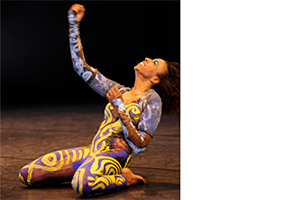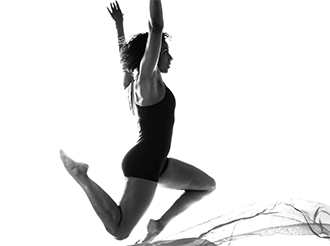Art comes in many forms and there is nothing more expressive than the form of the human body. This Friday, Travois will host dancer and choreographer Maura Garcia for an interactive artist talk. The director of the Kansas City Indian Center, Gaylene Crouser, introduced me to Maura as “an artist who knows other artists.” Here’s an interview glimpse between me and Maura of what awaits you this Friday.
Q: How do you choose the organizations and communities you partner with?
A: I used to cast a broad net and try to do collaborations with whatever nonprofits would answer my emails. 🙂 However, I realized that it is okay to specialize and be specific. Now, I generally try to create community projects within Native communities that I am a part of — Cherokee communities in Oklahoma and North Carolina, Kansas City Native community and Lawrence Native community.
When I tour, I reach out to the folks on whose homeland I am on, as well as urban Indian centers in other cities. I am also interested in working with organizations that serve survivors of sexual trauma.
In terms of where I present my performance work, the process differs. My agent and I seek to connect with venues that are interested in presenting Indigenous work, contemporary non-European work, work by women, new eclectic work or activist work, etc. The onus is on us to discover which venues would be interested in the work I am already making.
Q: Can you specifically discuss how you work with the Kansas City Indian Center and why their role is important today?
A: The first thing I did when I was considering relocating to Kansas City — before I even got here — was Google search the Kansas City Indian Center. I wanted to know about visiting, events and gatherings. It was one of the first places I visited. I ended up volunteering there, working there for a spell and now I am a volunteer again!
How important it was/is to me speaks a little about how important it may be for others too. Imagine that you are in a setting where there are no other people from a remotely similar cultural background or belief system. Imagine there is no mention of your culture in popular culture or everyday interactions. Or that when there is, it is offensive and completely dehumanizing. Imagine others think your people are imaginary and exist only in the past or in “Peter Pan.” If you were in that situation, you might find it a great relief to be in the presence of others who may have similar mindset, experiences and culture.
There are over 565 federally recognized tribes now (not including legitimate state recognized tribes in North Carolina and Virginia or the traditional communities in Florida or California that have no recognition) so naturally at a place like the Indian Center we are really INTERNATIONAL. However, many of our nations have similarities in core values, some sacraments and ways of being. We learn from each other and we strengthen each other so we can walk easier in the world. A lot of our people are also carrying heavy loads. To visit, and laugh, and be comfortable in your skin makes the load a little lighter. Or at least when they have to pick it up again, they have been a little rejuvenated and can keep on.

Q: You clearly value the power of story. Your interactive choreography and presentation for Travois First Fridays will focus on Dancing our Stories: Uplifting indigenous culture. Dance as connection to ancestors. Dance as liberation. Dance as activism.
Why does story matter and what does it mean for you to ‘dance our stories?’
A: That is a funny question for me. 🙂 Without story I/you/we can’t even know who we are. If we don’t know the right story or chose bad ones, we end up living false or off-course lives. We all have stories about ourselves. Sometimes they are very broad stories like the origin of our tribal nation, the story of when the Spanish came, or the beginning of the world. Sometimes they are very specific stories like the story of how my grandparents met, or of how I stole the chocolate cake when I was two. But regardless, the stories are little parts of us. Forgive me for turning to Harry Potter, but if horcruxes had a good equivalent, they would be stories. Parts of our soul are stored in stories.
So “dancing our stories” means several things to me. On one level, if we are dancing, we are really already dancing our stories. If we are dancing from our heart and using movement that reflects our souls, our stories are being told. I don’t know if these type of people exist, but I imagine someone could tell a person’s past and future by watching them dance. Some dance techniques encourage conformity. They may want you to dance not your story, but only the story of the chorus line or of the entire show. It may not work in some dance projects for people to be able to see individual and group stories on stage. They may want to see only the vision of the show. I want to see that too, the vision of the choreography, but when I work with others I want them to add the choreography of their story and vice versa. I want their body/spirit story added to the dance.
On another level, each story has movement embedded in it. Take the story of the Sequoyah, the inventor of the Cherokee writing system. He sat in his house for a long time, writing and rewriting possible writing systems. At one point they say his wife threw everything away because she resented his distraction. In that little snippet of story there is already choreography. Without being a mime (another powerful art form) you have enough prompts for a whole dance. You can explore possible choreography for “sat, long time, writing, rewriting, threw and away” for hours. In that little snippet story, there is enough movement for a dance. So, “dancing our stories” in that way too.
Q: The passion and fullness of life you bring to your dance, Maura is so visible in your photos and presence. How are you changing the world around you because of your art—the art of dance?
A: HA! Well one of my quotes (yes, I am going to quote myself) is “Every interaction with a loving being is an opportunity to positively affect the world.” Regardless if I am dancing or driving, how I treat all life around me is what changes the world. I happen to be a dancer, so I have the ability and the good fortune to also do that thru dance.
People at workshops and performances have told me that I made them believe in themselves, or try something new, or think about the world differently, or learned something that changed their lives. It would be nice to think I have some special power, but I don’t. What I can do, and try to do, is too remain open. If I am a conductor of light, then it can be shared with the others I interact with, whether on the stage or at the grocery store.
—
Maura Garcia will present an interactive demonstration for Travois First Fridays on November 3rd at 6:30 p.m. Maura uses her art to form connections, to uplift Indigenous cultural values and to explore the rhythms of the natural world.
Join us this Friday for her stimulating presentation, which will run concurrent to the surrounding photographic and social documentary art exhibition of Matika Wilbur’s Seeds of Culture-The Portraits and Stories of Native American Women. You may pre-register here to receive two complementary drink tickets: https://travois.com/news-events/first-fridays/.


